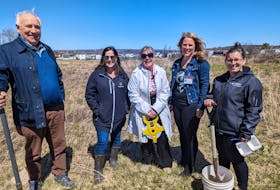
MacLELLANS BROOK – It could almost be considered an attack on our national pride, a treasured symbol of the country defaced.
In reality, it's just an eyesore. The problem is those ugly black spots on some maple leaves, mainly the leaves of the Norway maple.
The 'tar spot of maples' disease attacks the upper side of the leaves on affected trees resulting in black spots that give the fungal disease its name.
Allan Jackson, forestry technician at the local Department of Natural Resources office, said it's basically harmless for the trees.
"It's not supposed to have any longer term effects," he said.
Jackson, whose duties take him to the woods frequently, said it's a noticeable disease within towns.
"We get a few calls in towns.… I've noticed some along the (rural) roadways but it's quite prevalent in town."
He said the department has received calls about diseased trees this year and quite a few last year as well.
Jeff Morton, one of the grounds managers at the Nova Scotia Agricultural College in Bible Hill, said the tar spots seem to be a little less severe this year compared to last.
He said to his knowledge there isn't a lot of work being done to treat any infected trees because pesticide appears to be decreasing and fungicides are too expensive.
Neither the tree nor fungus is native to Canada, said Morton.
"It's a bit of an invader itself. There's a lot them out there. They seed themselves easily."
What causes the tar spots?
Chelsea Baird, horticulturalist for the Town of New Glasgow, said in a release that two factors promote the spread of the disease: a wet spring followed by a hot, humid summer and spore dispersal from leaves that were left behind the previous fall.
She said the best way to control the problem is to take preventative steps when the leaves fall from the diseased trees.
"The best management practice we can carry out at this time is to rake fallen, diseased leaves and dispose of them properly in municipal green bins, or bag them for roadside leaf collection," she said. "Reducing incidence of fallen leaves in the autumn can reduce the amount of spores present the following spring."
She said leaves shouldn't be placed in home compost piles because home composting doesn't reach a high enough temperature to kill the spores that spread the disease. Baird added that mulching the leaves may spread the diseased tissue and allow it to overwinter, ready to renew its attack again in the spring.
A little elbow grease goes a long way, she said.
"Limiting spore dispersal by raking fallen, diseased leaves must be a neighbourhood effort in order to be effective. Encourage and help out your neighbours by getting outside, getting some exercise, and enjoying the beautiful autumn weather we are so blessed with in our province."








